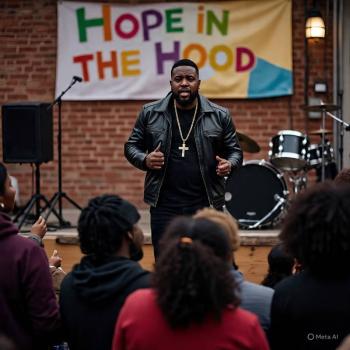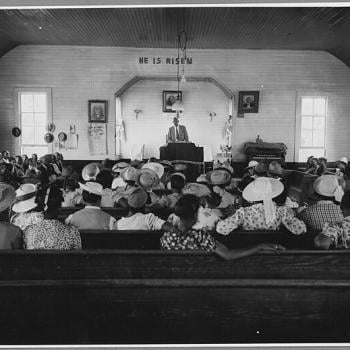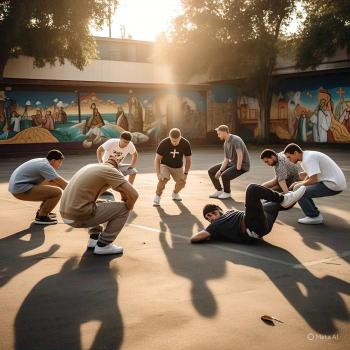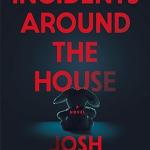The Christian Hip Hop cypher (also spelled, cipher) is a critical arena for community and shared testimony. Building on the history of the hip hop cypher, this engaged point articulates multiple viewpoints, elicits friendly competition, and establishes community support. For Christian Hip Hop artists, the cpher is the arena for discipleship, testimony, evangelism, community support (aka, ‘the church’), and fortifying sound scripture/biblical doctrine. The cipher is central to Hip Hop culture and remains a stable fixture. However, there are references when the sipher is distorted for economic sensibility, and misappropriated for mass market consumption. It’s this uphill battle where I locate the importance of the Christian Hip Hop cypher.

What is the cipher?
The cipher has its roots in African drum circles, Jamaican “rude boi” culture, the Congo Square in New Orleans, and eventually settling in the street consciousness/culture throughout the African diaspora, arriving in the Bronx, New York. The style of the circle remains central to the cipher. This arena is where expressed culture was shared between slaves on Sundays, by allowance of their slave owners. Ironically, it was “the Lord’s Day” where the ciphers were formed by the slaves. Language, culture, knowledge, history, and identity were shared between the slaves who often came from different parts of Africa (West Coast, Northern regions, parts of East Africa, and South Africa along the coastal areas). The progression of the African diaspora did not erase the cipher as agency for cultural demonstration and expression. Once the slave trade was formalized in the Deep South of America, drums were no longer allowed to be used by the slaves. Colonial oppression forced African slaves to use the rhythm of language to share cultural knowledge, culture, customs, and traditions. The context of the circle remained consistent. Serving as a religious signifier, with no beginning and no ending, the drum circle retained the rhythm of the language, contextualizing the beat.
In the post-slave era, the cipher found its way into the Black church. Preachers would incorporate this signifier in the tent services as they would preach, often for hours on Sundays, to their congregation. The language of the sermon prescribed the beat and the rhythm. This expressive practice would expand into secular Black music culture, most notably credited to James Brown, Marvin Gaye, and Sam Cooke. As disco appropriated this lyrical style, White pop culture replaced the highly charged lyrics with electronic drum beats. It took the Black youth in the Bronx, New York, to recuperate the core sermonizing element of this musical trajectory along with the evolving electronic music technology. Placing the importance of the lyrics over the beat, the DJ culture from Jamaica’s dance hall culture, coupled with the Black church sermonizing discipline, and layered atop a firm digital beat, which gave an updated version of the MC as witnessed in the dance halls. This became the early seeds of the Hip Hop rap/MC. DJ Kool Herc and his Soul Sonic Force were the pioneers in this field.
The street consciousness of the cipher was never reduced. The cipher continued to be the area where friendly battles were settled. The prolific off-the-cuff lyrical expositions of competitors showcased their position in the hierarchy of the street (later to be hypercompressed and narrated as the Black/African American ghetto). The cipher, for Hip Hop culture, continues to represent the location of street culture, community association, and partnership building. As Hip Hop culture progressed, the cipher has lost its roots and importance for positive representation. The global marketing of negative Hip Hop references (crime, misogyny, drugs, and money) has replaced the importance of the cipher for cultural collaboration. In the hands and eyes of the industrial Hip Hop/Hip pop global complex, the cipher has become a tool to market multiple Hip Hop/Hip pop artists. The exploitation of these artists, using he cipher as the vehicle, has transposed the roots of the cipher as a location of cultural survival and resistance to one of a billion-dollar industry standard.
Christian Hip Hop artists explore the cipher along the parallels of the Black church. The extension of this discipline to the street has lent itself comfortably to Christian Hip Hop artists versed in Hip Hop culture. The street consciousness and use of the cipher articulate each element of Christian Hip Hop: personal testimony, discipleship, evangelism, and scripture-centered discourse. These core elements of Christian Hip Hop culture align with the origins and roots of the cipher.

The Christian Hip Hop cipher
Examples of Christian Hip Hop artists who use the cipher to its fullest capacity are:
Each of these selections provides an example of a Christian Hip Hop cipher. The artists are situated in a context where the traditional circle is referenced. The artists take turns not to combat each other, but to follow three core principles of Christian Hip Hop: testimony, discipleship, and evangelism. Scripture knowledge is riddled throughout to substantiate the other elements. The individual style of each artist is present. The lyrics firmly articulate a dedication to their scripture knowledge and Christian faith.
When the cipher isn’t a cipher
There are instances when the cipher is used, but not along the guiding structure of the origins and intent of the cipher. In such cases, a collective of Hip Hop artists (rappers) “spit and flow” (present their lyrics and rhymes) along a predetermined theme. On the surface, this appears to be a cipher. There’s a collective of Hip Hop artists/rappers, in a circle or line, each taking turns to showcase their work. The distinction lies in the rhymes. The MC (Master of Ceremonies) has its origins in the dancehalls of Jamaica and the Caribbean. This was transposed outside of the dancehalls to the street and expanded to include a small group of individuals, each rhyming to prove their place in the hierarchy of the neighborhood. This is akin to the drum circles of West Africa and the performing ring in Congo Square. The winner of these friendly battles held the position of power/dominance in the street culture until he (this is a male-dominated art form) is challenged and won over by a competitor. The individual “winner” assumes the position equal to that of the Black church preacher. His rhymes would be the sermons which others in the surrounding neighborhoods would listen to, learn from, and work to emulate. The cipher serves as the testing ground and the arena for friendly combat to resolve issues of power, and where one constructs their identity in the culture.
When the cipher follows a predetermined theme, the element of the friendly battle is removed. Those involved are each articulating their relationship to the theme. The contemporary distortion of the cipher follows this structure. It is an example of how the Hip Hop industrial complex exploits artists for financial gain. Such a marketing technique is not new to Hip Hop, nor Black music culture. This operation follows the history of the minstrel shows, where African/African American artists were put on display for predominantly white audiences in America and Europe. These minstrel shows worked in a chain of theatres throughout the South and East Coast of America. The minstrel theaters were highly popular in their time (c. 1880s – 1940s). The Hip Hop industrial complex uses this same process to exploit Hip Hop artists/rappers globally. A production company will employ a group of Hip Hop artists/rappers to collaborate. The selected theme of the work is narrated individually, produced to work in a fixed form and style, and approved by the production company for mass market release. The resulting work is manufactured with the ability to be reproduced on demand. Each Hip Hop artist/rapper may retain their original “voice” in the work, but the overarching collaboration is what the Hip Hop industrial complex seeks to exploit to a global audience.
Christian Hip Hop artists engage this themed cipher representation, but not necessarily for exploitation. The ideology behind this use of the cipher is to gather close-knit Christian Hip Hop artists to present a single work to a larger audience who may otherwise not be exposed to their works. This style of cipher complements the discipleship, evangelic, and in most cases, the scripture-centered lyrics. However, the testimony element of core Christian Hip Hop is exchanged for a collective theme. In addition, the free-flowing nature of the cipher is also replaced with edited lyrics to fulfill a predetermined structure and style. The indeterminate, dynamic nature of the cipher is exchanged for a polished work with the ability to be replicated on demand. This is where the cipher is not a cipher.
An example of this can be seen in a work produced by Kingdom Music, “Free and Forgiven.”
This track includes four different artists on the Kkdngom Music roster. Each has a distinct style and “voice.” The theme was predetermined, and each artist/rapper takes their turn to express how they relate to the theme. Starting with the founder of Kingdom Music, Bryan Trejo, who has the longest portion in this track, the others follow using the theme of being “free and forgiven” through salvation. The work includes the other core elements of Christian Hip Hop. What stands out in this example is the use of a hook, a chorus. The phrase “free and forgiven,” the title of the track, is used to close the section of one artist and segue to the next. This places the structure in a pop music form rather than a Hip Hop cipher form, which the track is signifying. This use of the cipher form has proven to be useful in Christian Hip Hop. Most listeners are unconsciously aware of the pop song structure, seeing its institutionalization in pop culture on the largest platform. Not being aware of the history of the cipher will not interfere with the intent of the track. Audiences can follow a simple form, easily digest the lyrics, and phenomenologically connect with the track, the artists, and the lyrics, which meander through biblical references and personal testimony. Though this is not technically a cipher, this model serves to introduce audiences to a variety of artists in a simple context.
Another example of a work following along these same lines is “Son of a King” by Psalms Of Men.
This use of the cipher follows that of the Hog Mob and Bizzle. What separates this work from the others is the prominent use of scripture-centered lyrics from each artist. There is no formal cipher circle represented. However, what Psalm Of Men explores is the reality of life. Where Bizzle’s Cipher 2016 takes place in a playground, Psalm Of Men engages the same reality of living and sharing scripture in a contemporary context through the activity of life. “Son of a King” also borrows from Bryan T’s example, where there is a hook in the track, “Son of a King/ I got the crown now/ Every knee gonna have to bow down”
The hook quotes a few scripture verses,
Philippians 2:10-11 – That at the name of Jesus every knee should bow, of things in heaven, and things in earth, and things under the earth;
Romans 14:11 – For it is written, As I live, saith the Lord, every knee shall bow to me, and every tongue shall confess to God.
Isaiah 45:23 – I have sworn by myself, the word is gone out of my mouth in righteousness, and shall not return, That unto me every knee shall bow, every tongue shall swear.
In addition, there is a subtle reference to Psalm 23:4, “I walk through the valley/ But I fear no evil”
Even though I walk through the darkest valley, I will fear no evil, for you are with me; your rod and your staff, they comfort me. (NIV)
This track is rich in scripture and the use of the cipher in a movement. This added element, motion, and the embodiment of each element of Christian Hip Hop (testimony, discipleship, evangelism, scripture-centered) and the appropriation of a hook place this work on a different level than others.
The evolution of the Christina Hip Hop cipher
The works presented here demonstrate the evolution of the cipher in the hands of Christian Hip Hop artists. Different than the current Hip pop industrial complex marketing strategy of secular Hip Hop artists, Christian Hip Hop artists work along a more traditional process of the cipher. Invoking the core elements of Christian Hip Hop (testimony, discipleship, evangelism, scripture-centered) and the borrowed use of the hook in some examples, the cipher for Christian Hip Hop artists serves to speak to faith-based and non-faith-based audiences. Not following the practice of the large Hip Hop industrial market complex, Christian Hip Hop artists can keep their works secure and in line with a community context. The cipher allows for artists to take the gospel truth to multiple audiences. In the hands and rhymes of Christian faith-based Hip Hop artists, the cipher is an instrument for evangelism to build disciples by sharing personal testimony and commitment to the scripture, all wrapped around a firm Hip Hop beat.














